The Printer's Helper was published by The Kelsey Company for the users of its small (mostly tabletop) printing presses. I don't have the first 362 issues of this periodical, or any beyond No. 470 (1983). The number of issues in each year varied. I do not yet know when it started or ceased publication.
My notes about the contents of these issues are entirely arbitrary - just things that caught my eye as I was browsing. I'll tend to emphasize the technical and ignore the business/promotional items. When I started, I tried to note repeated items; after a while I gave up.
Each icon/image below links to a PDF of the corresponding issue. Each of these PDFs is about 40 Megabytes in size. Unless you have a high-speed net connection, you would do best to download them individually and read them offline. I am informed that this is becoming increasingly difficult to do on computing devices named after pomaceous fruits.

No. 363 (1963)
DAMAGED copy (portion clipped out). Thin spacing material. Dryer for presswork. Home-made rule mitering fixture. Type: Modern Ornaments and Decorators (Fonts C, D).
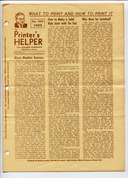
No. 365 (1963)
Printing rule forms. Kelsey Line-Up Gage ad. Soggy newspapers to fill up around cuts. Type: Century family.
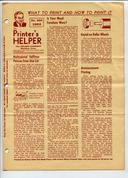
No. 366 (1963)
Multicolored halftones from one cut. Keyed-on roller wheels (trucks). Type selection for announcements. Use of perforating rule. Setting curved lines (cutting wood blocks with a jigsaw). Type: Margery.
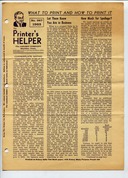
No. 367 (1963)
(Lining) Copperplate Gothic. Estimating for spoilage. Speed tips for typesetting. Paneled cards (die cut). Type: Modern Ornaments and Decorators (Fonts C, D).
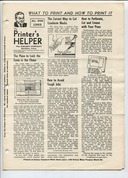
No. 368 (1963)
The plce to lock the form in the chase (with a good illustration of a simple running lockup). Do not undercut linoleum blocks. How to perforate, cut, and crease. Type: Heavy Old English. Tissue/onionskin for gauging.
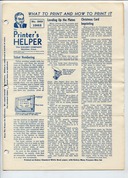
No. 369 (1963)
Ticket numbering. Leveling the platen. Slanted lockup. Refrigerating composition rollers. Type: Egyptian Light.
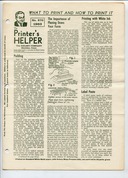
No. 370 (1963)
Padding (making pads). Planing the form. Printing with white ink. Making a label paste. Bookplates. Hands and flaps when printing envelopes. Disparging remarks on dampened paper printing in the time of Franklin. Type: Christmas Cut, 1964 Calendar Cut.
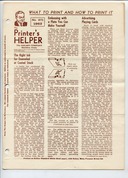
No. 371 (1963)
Ink for enameled or coated stock. Embossing with a plate you can make yourself. Type: "Christmas Type," Garamond, Modern Ornaments and Decorators (Font D).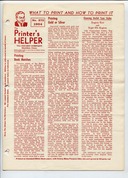
No. 372 (1964)
Tip on printing gold or silver. Vertical type alignment (Title, Common, and Art Lines). Type: English Text and Light Old English, Park Lane Initials, Monogram Frames.
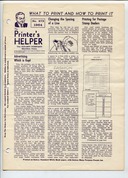
No. 373 (1964)
Changing the spacing of a line. Sliding and slurring. Roller hook advice. Punctuation. Type: Bernhard Fashion.
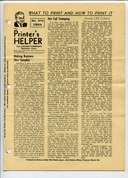
No. 374 (1964)
Summer and winter rollers. Old ink. Royal Gold Foil Stamping Machine. Shop-made counterbalance for a tabletop press. The Washington hand press. Type: Goudy Old Colony.
Special note: This issue advocates the use of rubber bands to tie up forms. This is a pernicious idea and an abominable practice which should be eliminated from all printing offices. Sooner or later, old forms which have escaped distribution will end up in the typefounder's pot to be transformed into lovely new type. Nothing smells quite as bad as burning rubber bands in the pot. If you value the good nature and pleasant demeanor of your friendly local typefounder, don't do it.

No. 376 (1964)
Setting curved lines using bent leads and hot metal. Typan and pressbord identified and illustrated on press. Space and quad case. Type: Beacon Hill, Modern Ornaments and Decorators (Font C).
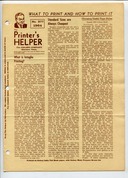
No. 377 (1964)
What is intaglio printing? Halftones with type or zinc etchings. Type: Goudy Old Colony Bold.
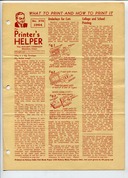
No. 378 (1964)
Envelope sizes. Underlays for cuts. Grease gun as ink applicator. Type: Ad-News Condensed, calendar cuts (perpetual, 1965).

No. 398 (1966)
To get the correct margin for feeding. Underlay for rule. Informals (informal card text and use). Commas and quotation marks. Making a gum for labels and stickers. Lifting lines of type. Type: Beacon Hill, Park Lane Initials, Typo Roman.
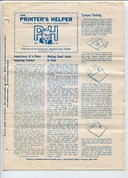
No. 411 (1969)
Making good joints in rule. Typman packing. Printer's Dictionary: B. Effect of temperature; static electricity. Type: Century Family (Century Roman shown).
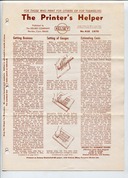
No. 418 (1970)
Setting gauges (gauge pins). Printer's Dictionary: C. Slippage streaks. Extension feed guides. Home-made rule mitering fixture (abridge from No. 363). Type: Garamond.
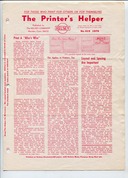
No. 419 (1970)
Layout and spacing. Printer's Dictionary: C. Tying up standing forms. Getting ink to dry. Quotation marks (use sparingly) Type: Invitation Text, calendar cuts for 1970, seasonal cuts.
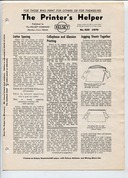
No. 420 (1970)
Letterspacing. Cellophane and glassine printing. Jogging sheets together. Summer and winter rollers. Printer's Dictionary: C. Type: Margery (see also No. 366), Park Lane Initials.

No. 421 (1971)
Script type logotypes. Winter and summer rollers. Using two sizes of quad rule to get type lines in. Facsimile typewritten letters. Printer's Dictionary: C. Type: Egyptian Light.
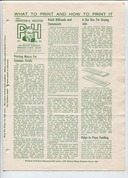
No. 422 (1971)
A hot box for drying jobs. Linoleum block cuts. If letters pull out of the job while running. To freshen up dead rollers. Type: [none]

No. 423 (1971)
Printing large sheets on small presses. Paper (history). Printer's Dictionary: D. Type: Minuet. Combination Monographs, Chateau Initials, Riverside Monogram Initials.
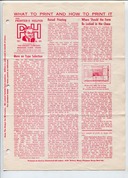
No. 424 (1971)
Type selection. Raised printing. Where should the form be locked in the chase? Remedy for hollow platens. Glycerine for loosening sticky type. Quotes in type. Oiling. Printer's Dictionary: D, E. Type: Typo Roman. Ornaments and Zodiac Symbols.
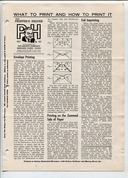
No. 425 (1972)
Envelope printing. Printing on the gummed side of paper. Foil imprinting. Setting gauge pins accurately. Heavy forms. Leads and leading. Printer's Dictionary: E. Type: Kelsey Script. Playing Card Indicators No. 1.
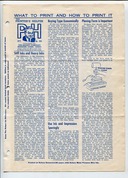
No. 426 (1972)
Stiff inks and heavy inks Usin ink and impression sparingly. Planing a form. Mortised cuts. Furniture. Printer's Dictionary: E. Type: Beacon Hill.
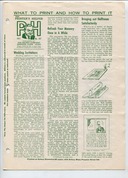
No. 427 (1972)
Bringing out halftones satisfactorily. Nylons as wiping rags. Printing on bond paper. Printer's Dictionary: E, F. Type: Park Avenue.
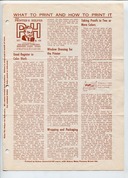
No. 428 (1972)
Good register in color work. Taking proofs in two or more colors (with friskets). Naming your shop. Printer's Dictionary: F. Type: Hand Carved.
With reference to the promotion of cellophane tape for tying up lines, see the notes on using rubber bands to tie up forms, above

No. 429 (1973)
Quoins for locking. Diagrams of good lockup, conventional and chaser. Round cornering by hand. Proof presses. Printer's Dictionary: F, G. Type: Sans Condensed.
Note: Many Kelsey chases were designed with screws for lockup and did not use quoins.

No. 430 (1973)
Figuring small sheets cut from large. Punched work. Creasing paper aned card stock. Tape supplanting string for packaging. Cutting paper with a plow. Feeding napkins. Billhead layout. Printer's Dictionary: G. Type: Fairfield.
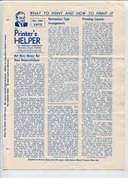
No. 431 (1973)
Printshop layouts. Ruggles Press (1850s). Printer's Dictionary: H. Type: Regent, Park Lane Initials.
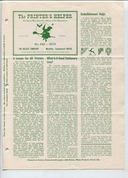
No. 432 (1973)
Ancient printers' customs (Moxon). How to print irregularly shaped stock. Printer's Dictionary: H. Type: Bond Gothic. Modern Ornaments and Decorators (Font C). Margery (see also No. 366).
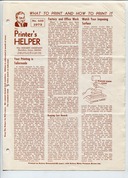
No. 433 (1973)
Watch your imposing surface. How to figure the right amount of type for a job. Setting wedding announcements. Printer's aprons. Position of J and U in the case. Printer's Dictionary: H, I. Type: Big Top. Modern Bodoni.
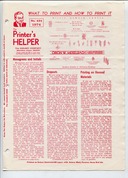
No. 434 (1974)
Monograms and initials. Types dropping out of the form. Printing on unusual materials. Mitered or beveled corners. Shop-made jogging box. Printer's Dictionary: I. Type: Combination Monograms. Chateau Initials. Riverside Monogram Initials.
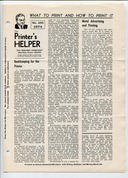
No. 435 (1974)
Bookkeeping for the printer. Adjust impression before printing. Locking the form so that it will lift. Printer's Dictionary: I, J. Type: Steelplate Shaded. Modern Ornaments and Decorators (Font D). Patriotic cuts.
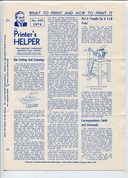
No. 436 (1974)
Die cutting and creasing. A shop-made treadle for a Kelsey 5 x 8 press. Two-color printing. Using a carbon sheet for pulling a proof. Printer's Dictionary: K, L. Type: Bond Gothic. Calendar cut for 1975.
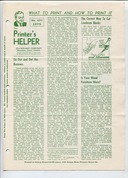
No. 437 (1974)
Do not undercut linoleum blocks (also in No. 368). How fonts of type are made up by the typefounder. Vertical alignment of type. Cellophane for gauging. Locking form slantwise in chase to improve inking, with diagram. Printer's Dictionary: L. Type: Margery (see also No. 366).
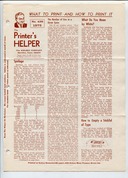
No. 438 (1975)
White paper making. How to empty a stickful of type. Mixing black and colored ink. Quieting the ink plate dog. Printing from embossed address plates. Soft or hard tympan packing. Printer's Dictionary: L. Type: [none]
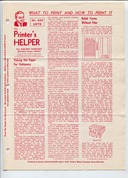
No. 439 (1975)
Ruling forms without pain. Quad rule illustrated. Cleaning brass rule. Table mounting for Kelsey 5x8. Printing as physical therapy. Protecting the tympan from perforating rule. Printer's Dictionary: L. Type: Chelten Bold.
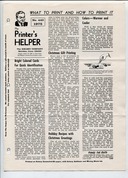
No. 440 (1975)
Colors - warmer and cooler. Bookplates. Onionskin for accurate gauging. Creme Oil Hair Tonic to lubricate the press. Printer's Dictionary: L, M. Type: New Yorker.
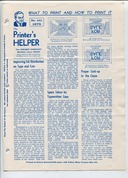
No. 441 (1975)
Improving ink distribution. Space taken by typewritten copy. Proper lcok-up in the chase, with illustrations. How to print envelops [sic]. The correct way of lining type with rule. Cut-out panels in stationery and folded sheets. Printers' Marks. Printer's Dictionary: M. Type: [none]
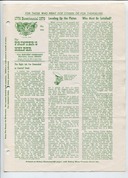
No. 442 (1976)
The right ink for enameled or coated stock. Leveling up the platen. Keeping large sheets clean when printing. Shop-cut key seats in roller cores. Ticket numbering. Makeready (user-submitted method). Printer's Dictionary: M, N. Type: Egyptian Light, Perpetual Calendar No. 9, Calendar Cut for 1976.
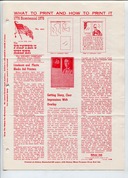
No. 444 (1976)
Linoleum and plastic blocks. Overlay. Printer's Dictionary: O. Type: Calendar Cut for 1977.
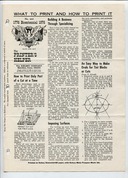
No. 445 (1976)
How to printonly part of a cut at a time (friskets). Making ovals for tint blocks or cuts. Accurate rule joints and miters (repeat of earlier shop-made fixture). Lowe Press (1856). Extension feed guides. Printer's Dictionary: O, P. Type: New Yorker. Park Lane Initials.
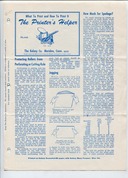
No. 446 (n.d.)
Jogging (by hand). Protecting rollers from perforating or cutting rule. How much for spoilage. Tying forms. Correct use of quoins. A printing house of the 1600's [sic, not 1600s], with indoor eagles, illustrated. Printer's Dictionary: P. Type: Margery.

No. 447 (n.d.)
Color harmony. Rubber bands to tie forms again (a terrible idea from the typefounder's point of view; see notes on using rubber bands to tie up forms, above ). Impression and papercutting in Franklin's time. Type in mortises or cutout electros. Glossy effects. Two colors in one operation. Printer's Dictionary: P. Type: Bond Gothic.
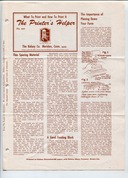
No. 448 (n.d.)
Thin spacing material. Planing the form. Window envelopes. Perforating. Dwell on hand press. Printer's Dictionary: P. Type: Ornaments (Font X). Modern Ornaments and Decorators (Font D). Calendar cut for 1978.

No. 449 (n.d.)
Business cards discussed. Composing stick rest. Finger cots for press feeding. Printer's Dictionary: P. Type: Westminster Text / Goudy Text. Modern Ornaments and Decorators (Font C). Perpetual Calendar No. 9.
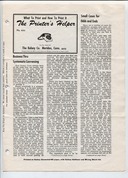
No. 450 (n.d.)
Small cases for odds and ends. Unusual card layouts. Setting around cuts. Shop-made feed board. Pile your sheets so that they will not offset. The Washington Hand Press. Keyed-on roller wheels (trucks) (again). Printer's Dictionary: P. Type: Modernistic. Typo Roman.
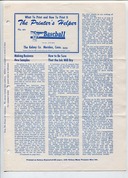
No. 451 (n.d.)
How to be sure that the ink will dry. Gauges, panels and platen extensions. Vignette halftones. Stippled or pebbled surface made by printing sandpaper. Printer's Dictionary: P. Type: Beacon Hill.

No. 452 (n.d.)
How to perforate, cut, and crease with your press. How to clean your type form properly. Easy makeready on large form work. Printer's Dictionary: Q. Type: Copperplate Gothic. Hand Carved.
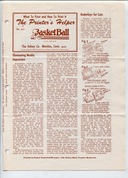
No. 453 (n.d.)
Eliminating muddy impression. Underlays for cuts. Origin of the Printer's Devil. Offset on your tympan sheets. Printer's Dictionary: Q, R. Type: Chelten Bold. Invitation Text.
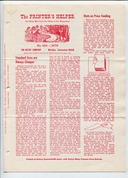
No. 454 (1979)
Hints on press feeding. Roller Tension and slurring. Cleaning type cases. Printer's Dictionary: R. Type: Modern Script. Mayfair Initials.
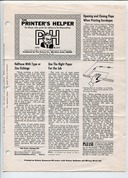
No. 455 (1979)
Halftone with type or zinc etchings. Opening and closing flaps when printing envelopes. Tying up forms. Rule may require underlay. Work and Turn. The parts of a panel or rule box, exploded diagram. Printer's Dictionary: R. Type: Clarendon.

No. 456 (1980)
Numbering machine work. Best impression with least amount of work. Tolerances for leads and slugs. Tympan, paper, and pressboard diagram. Old ink. Kelsey at 108 years. Number of leads to a pound. Cutting heavy rule. Printer's Dictionary: R, S. Type: Combination Monographs. Chateau Initials.
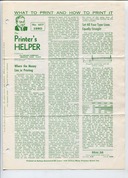
No. 457 (1980)
Set all your type lines equally straight. Rule may require underlay. Raised printing. Dropouts: drawouts and pullouts. Printer's Dictionary: S. Type: Garamond. Egyptian Light.
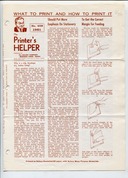
No. 458 (1981)
To get the correct margin for feeding. Proper tympan packing. Paint and varnish remover for cleaning crusted type. WHen a gauge pin would be in the way. Why some type faces have two or more letter sizes on a single body (lining faces, mostly lining gothics). The place to lock the form in the chase. Printer's Dictionary: S. Type: Bond Gothic. Shadow. Calendar Cut for 1982. Modern Ornaments and Decorators (Font D).
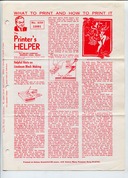
No. 459 (1981)
Helpful hints on linoleum block making (longer article than before). The several names of the Kelsey Company. Hot stamping attachment (preannouncement). Rubber base inks. How do you pronounce it? Testing the platen for even impression. Type styles used in The Printer's Helper. What causes type to be off its feet? Printer's Dictionary: S, T. Type:
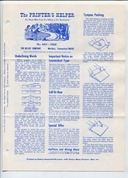
No. 460 (1982)
Underlining words (use of rule). Connecticut Foundry Type to be offered in complete large fonts only. Tympan Packing. The colonial press in America. How to perforate, cut, and crease with your press. Tying up a form. How to prevent offsetting. How to distinguish foundry type from other kinds. Printer's Dictionary: T. Type: Modern Ornaments and Decorators (Font C). Birthday and patriotic cuts.
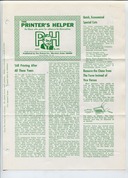
No. 461 (1982)
Note: This issue marks a reduction in size from four pages to two. Remove the chace from the form instead of vice versus [sic]. Heather Vellum pulled from market to prevent counterfeiting. Setting gauge pins accurately.

No. 462 (1982)
The cheaper the bond [paper], the easier to print. The parts of a panel or rule box. Watermark effect (castor oil and alcohol). How to get a gray tint in any color.

No. 463 (1982)
Good ink distribution on large jobs. Tying forms. Wax instead of typemetal for curved or oval setting.
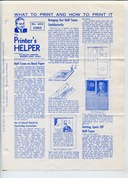
No. 464 (1982)
Half-tones on bond paper. Bringing out half-tones satisfactorily. Getting spots off half-tones. Cutting and rule dies. Using an engraver's die in a platen press.
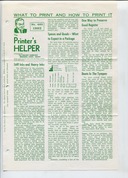
No. 465 (1982)
Stiff inks and heavy inks. Spaces and quads: what to expect in a package. One way to preserve good register (shove the chase). Dents in the typan. Printing on unusual materials.

No. 467 (1983)
Turning rollers to get rid of slurs. Printing trade customs (modern trade practices). Raised printing.
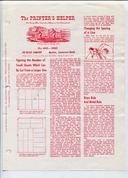
No. 468 (1983)
Figuring small sheets cut from large. Changing the spacing of a line. Brass rule and [type]metal rule. Printing large sheets on small presses. Rubber bands to tie forms, again. This pernicious practice just will not die. See notes on using rubber bands to tie up forms, above ).
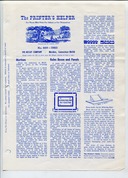
No. 469 (1983)
Mortises. Rule boxes and panels. Making fancy rule with a printer's saw. Raised printing. Taping roller wheels.
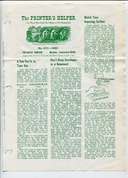
No. 470 (1983)
A few don'ts in type use. Watch your imposing surface. When the job doesn't seem to lock up tightly. Bodkins and tweezers.
The Kelsey material reprinted here was published in the United States without copyright notice at a time when such notice was required to secure copyright. It therefore entered the public domain upon initial publication. These digital reprints remain in the public domain.
All portions of this document not noted otherwise are Copyright © 2013 by David M. MacMillan and Rollande Krandall.
Circuitous Root is a Registered Trademark of David M. MacMillan and Rollande Krandall.
This work is licensed under the Creative Commons "Attribution - ShareAlike" license. See http://creativecommons.org/licenses/by-sa/3.0/ for its terms.
Presented originally by Circuitous Root®
Select Resolution: 0 [other resolutions temporarily disabled due to lack of disk space]